Upwards movement fits the alternate hourly Elliott wave count.
With support now from volume today, the hourly wave counts for the short term picture are swapped over.
Summary: A target for upwards movement to end is now at 1,349. Thereafter, expect a downwards swing to support, which is at about 1,310 to 1,305.
Only the most experienced of traders should attempt to trade when price is clearly consolidating as it currently is for Gold and GDX. The rest should either hedge or wait for a breakout and trade the next trend. Always use stops and invest only 1-5% of equity on any one trade.
If upwards movement does continue, then it may offer a good opportunity to open a short side of a hedge. If any members are holding a long position opened earlier, this could be the other half of your hedge.
New updates to this analysis are in bold.
Grand SuperCycle analysis is here.
Last in-depth historic analysis with monthly and several weekly charts is here, video is here.
There are multiple wave counts at this time at the weekly and monthly chart levels. In order to make this analysis manageable and accessible only two will be published on a daily basis, one bullish and one bearish. This does not mean the other possibilities may not be correct, only that publication of them all each day is too much to digest. At this stage, they do not diverge from the two possibilities below.
BULLISH ELLIOTT WAVE COUNT
FIRST WEEKLY CHART
Cycle wave b may be a single zigzag. Zigzags subdivide 5-3-5. Primary wave C must subdivide as a five wave structure and may be either an impulse or an ending diagonal. Overlapping at this stage indicates an ending diagonal.
Within an ending diagonal, all sub-waves must subdivide as zigzags. Intermediate wave (4) must overlap into intermediate wave (1) price territory. This diagonal is expanding: intermediate wave (3) is longer than intermediate wave (1) and intermediate wave (4) is longer than intermediate wave (2). Intermediate wave (5) must be longer than intermediate wave (3), so it must end above 1,398.41 where it would reach equality in length with intermediate wave (3).
Within the final zigzag of intermediate wave (5), minor wave B may not move beyond the start of minor wave A below 1,236.54.
Within the diagonal of primary wave C, each sub-wave is extending in price and so may also do so in time. Within each zigzag, minor wave B may exhibit alternation in structure and may show an increased duration.
Within intermediate wave (1), minor wave B was a triangle lasting 11 days. Within intermediate wave (3), minor wave B was a regular flat lasting 60 days. Within intermediate wave (5), minor wave B may last as long as 40 to 60 days. So far it has lasted 53 days (refer to daily chart) and the structure is incomplete.
At this stage, minor wave B may now be a combination or triangle. These two ideas are separated out in daily and hourly charts below.
This first weekly chart sees the upwards wave labelled primary wave A as a five wave structure. It must be acknowledged that this upwards wave looks better as a three than it does as a five. The fifth weekly chart below will consider the possibility that it was a three.
FIRST DAILY CHART – COMBINATION
Minor wave B may be a double combination. Double combinations are very common structures. The first structure in the double may have been a regular flat correction labelled minute wave w.
The double is joined by a three in the opposite direction, a zigzag labelled minute wave x.
The second structure in the double would most likely end about the same level as minute wave w, at about 1,303.08, so that the whole structure takes up time and moves price sideways. That is the purpose of double combinations.
Minute wave y may be either one of a zigzag, flat or triangle. Within minute wave y, minuette wave (a) will subdivide as either a three or a five, so all of these possibilities remain open. A zigzag would be most likely as combinations with one flat and one zigzag are the most common. A flat correction would be less likely as double flats are uncommon. A triangle would also be less likely as they are not common structures within combinations.
There is no upper invalidation point for minuette wave (b). If minute wave y is a flat correction, then minuette wave (b) may make an new high above the start of minuette wave (a) at 1,356.12.
HOURLY CHART – COMBINATION
Minuette wave (b) may be continuing higher as a regular flat correction, and within it subminuette wave b is a 0.94 correction of subminuette wave a. The target for subminuette wave c expects it to exhibit the most common Fibonacci ratio to subminuette wave a.
Subminuette wave c would be very likely to make at least a slight new high above the end of subminuette wave a at 1,347.58 to avoid a truncation.
When subminuette wave c is a completed five wave structure, then a trend change and a new downwards wave would be expected.
Assume that an upwards swing should continue while price remains within the yellow best fit channel. If price breaks below this channel, then assume the upwards trend may be over and a new downwards trend may have begun.
HOURLY CHART – COMBINATION – ALTERNATE
It is still possible that minuette wave (b) was over at the last high. Minuette wave (c) may be unfolding lower as an impulse. It may also be an ending diagonal (but that will not yet be charted), and it would expect the same direction at this stage.
Subminuette wave ii may end about the upper edge of the green Elliott channel. Subminuette wave ii may not move beyond the start of subminuette wave i above 1,347.58.
SECOND DAILY CHART – TRIANGLE
This alternate daily chart is identical to the first daily chart up to the high labelled minor wave A. Thereafter, it looks at a different structure for minor wave B.
Minor wave B may be an incomplete triangle, and within it minute wave a may have been a double zigzag. All remaining triangle sub-waves must be simple A-B-C structures, and three of the four remaining sub-waves must be simple zigzags. One remaining sub-wave may be a flat correction.
Minute wave b may be a complete single zigzag. Minute wave c downwards must now complete as a simple correction, very likely a zigzag. Minute wave c of the triangle may not move beyond the end of minute wave a below 1,303.08. This invalidation point is black and white for both a barrier or contracting triangle; there is no room for subjectivity.
This alternate wave count expects weeks of choppy overlapping movement in an ever decreasing range.
Triangles normally adhere very well to their trend lines. The triangle trend lines are commonly tested within the triangle sub-waves. Minuette wave (b) within minute wave b may have found support at the a-c trend line, and this indicates where minute wave c may end.
Minute wave d of a contracting triangle may not move beyond the end of minute wave b above 1,356.12. Minute wave d of a barrier triangle should end about the same level as minute wave b; the triangle will remain valid as long as the b-d trend line remains essentially flat. In practice, this means minute wave d can end slightly above 1,356.12. This invalidation point is not black and white; it involves an area of subjectivity.
Contracting triangles are the most common type. Barrier triangles are not common, but nor are they rare.
A separate hourly chart will not be published today for this wave count because it would now be exactly the same as the first wave count. Both wave counts expect a zigzag is unfolding lower.
BEARISH ELLIOTT WAVE COUNT
FIFTH WEEKLY CHART
There were five weekly charts published in the last historic analysis. This fifth weekly chart is the most immediately bearish wave count, so this is published as a bearish possibility.
This fifth weekly chart sees cycle wave b as a flat correction, and within it intermediate wave (B) may be a complete triple zigzag. This would indicate a regular flat as intermediate wave (B) is less than 1.05 the length of intermediate wave (A).
If cycle wave b is a flat correction, then within it primary wave B must retrace a minimum 0.9 length of primary wave A at 1,079.13 or below. The most common length of B waves within flats is from 1 to 1.38 times the length of the A wave. The target calculated would see primary wave B end within this range.
I have only seen two triple zigzags before during my 10 years of daily Elliott wave analysis. If this wave count turns out to be correct, this would be the third. The rarity of this structure is identified on the chart.
FIFTH DAILY CHART
Minor wave 1 may have been a relatively brief impulse over at the low of the 8th of February. Thereafter, minor wave 2 may be an incomplete double combination.
The first structure in the double may be a zigzag labelled minute wave w. The double may be joined by a three in the opposite direction, a zigzag labelled minute wave x. The second structure in the double may be an incomplete triangle labelled minute wave y. This structure may yet take some weeks to complete. In my experience a double combination with a triangle for minute wave y is not very common. This reduces the probability of this wave count, but it remains valid.
This wave count is a good solution for this bearish wave count. All subdivisions fit and there are no rare structures so far within intermediate wave (C).
TECHNICAL ANALYSIS
WEEKLY CHART
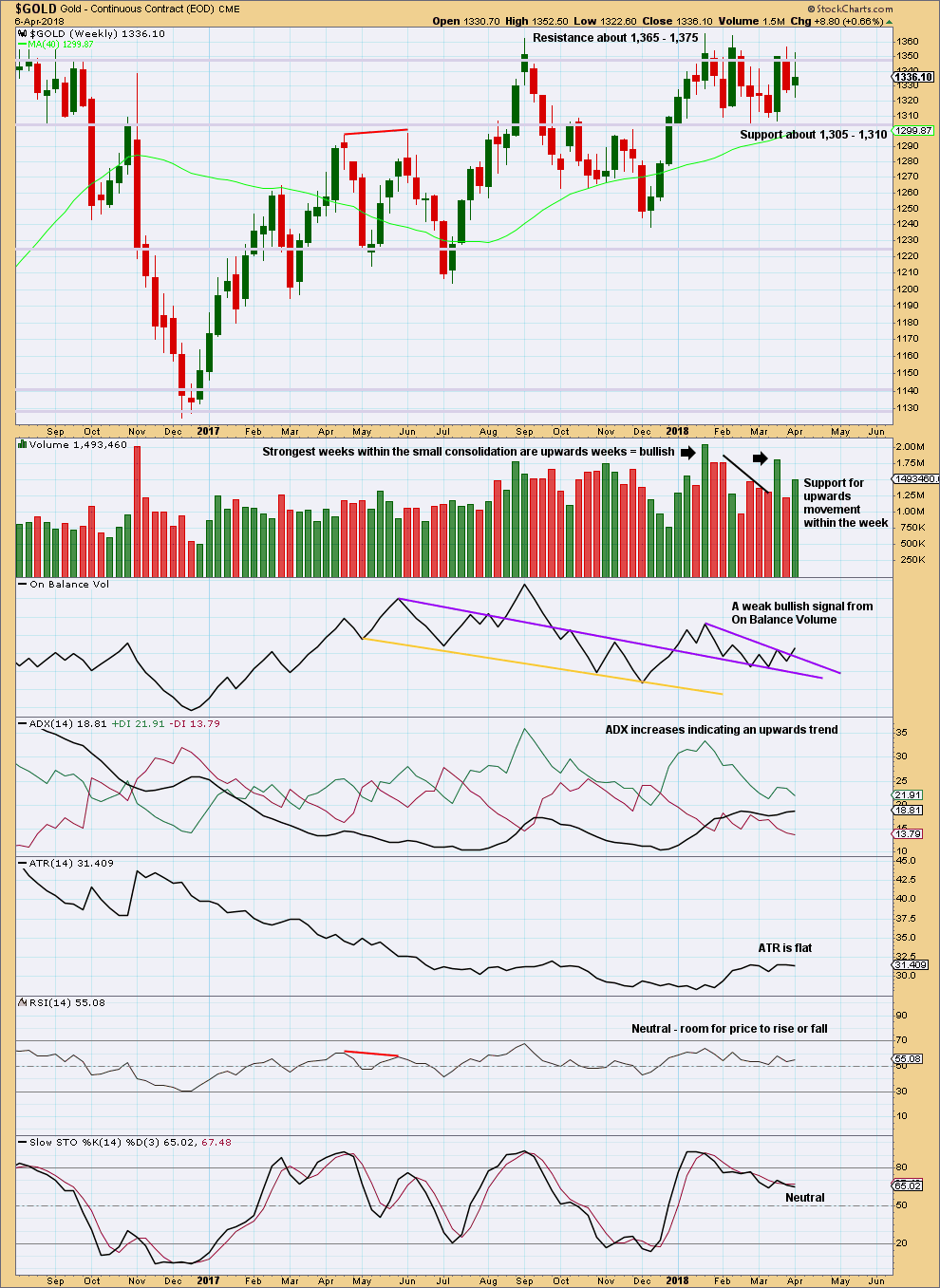
Click chart to enlarge. Chart courtesy of StockCharts.com.
Gold is within a small consolidation with resistance about 1,365 to (final) 1,375 and strong support about 1,310 to 1,305. Volume suggests an upwards breakout is more likely than downwards.
The bullish signal this week from On Balance Volume is weak because the purple line, which has been breached, has a reasonable slope and was only tested twice prior.
DAILY CHART
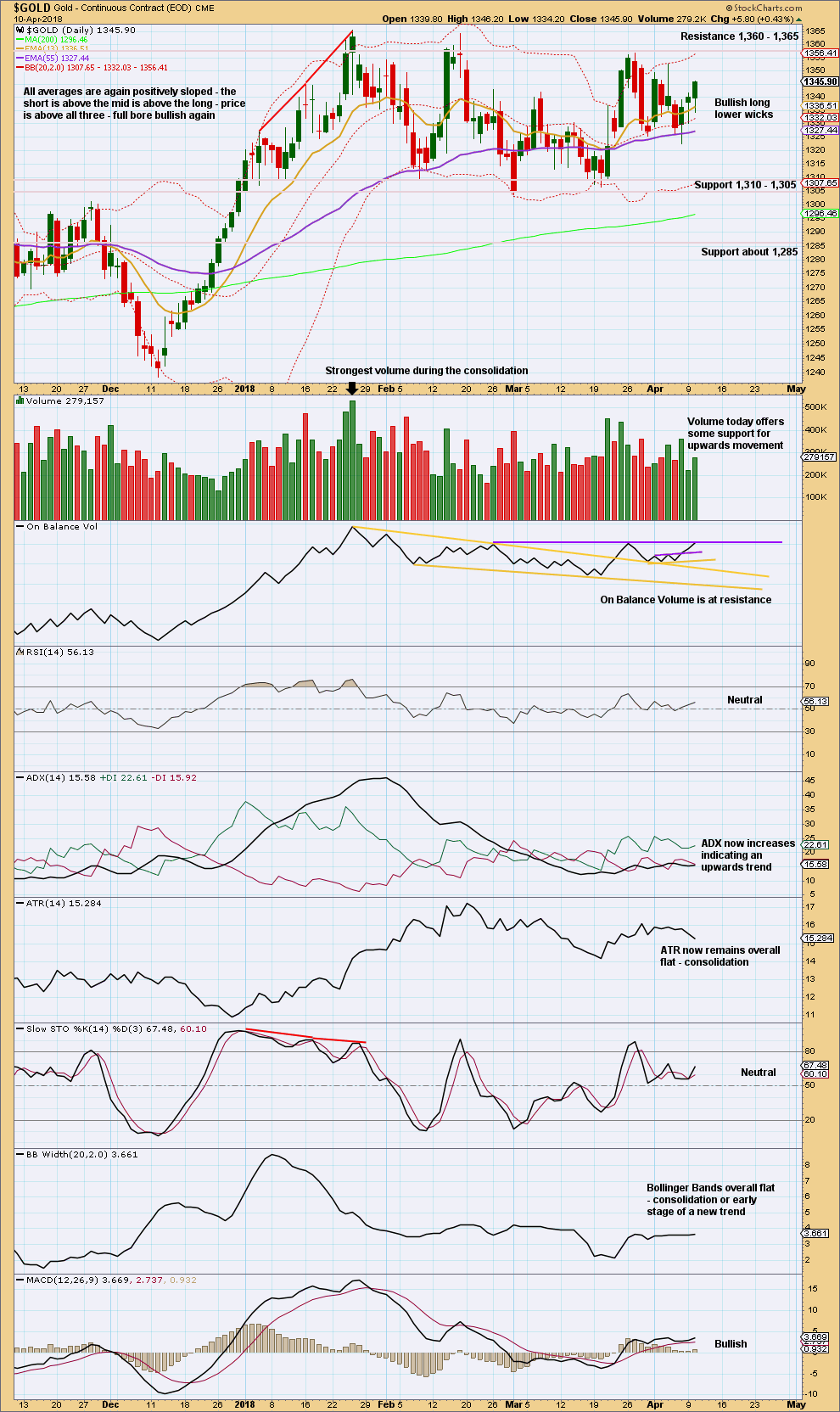
Click chart to enlarge. Chart courtesy of StockCharts.com.
Gold is within a smaller consolidation that began back on about the 3rd of January. This consolidation is delineated by resistance about 1,360 to 1,365 and support about 1,310 to 1,305. It is the upwards day of the 15th of January that has strongest volume during this consolidation. This suggests an upwards breakout may be more likely than downwards.
Some support from volume today changes the short term outlook to more bullish. Resistance may again be tested here. The long lower wicks are now very bullish for the short term.
On Balance Volume is at resistance. But this resistance line has weak technical significance, because it is only just able to be drawn and has only two anchor points.
GDX WEEKLY CHART
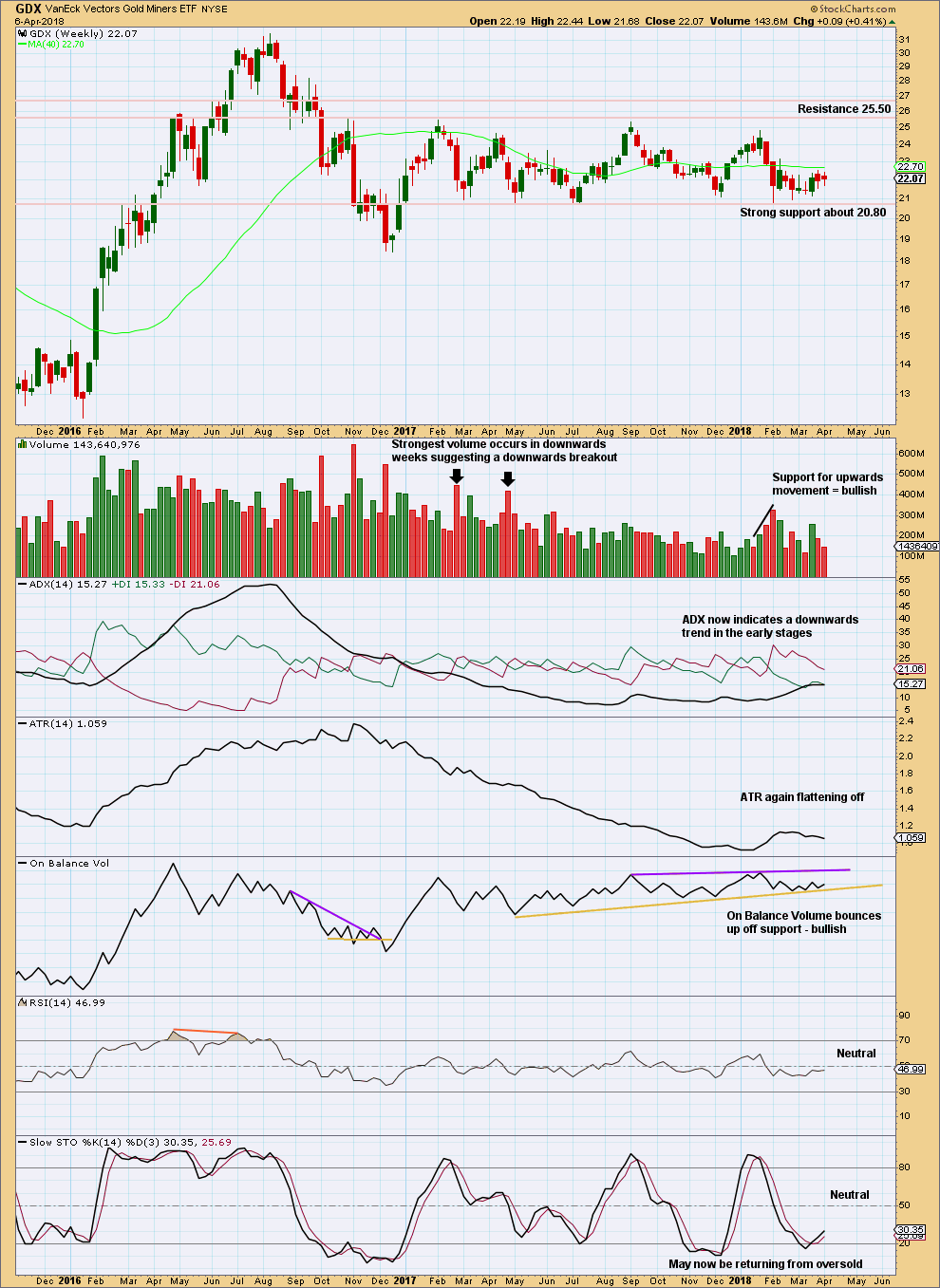
Click chart to enlarge. Chart courtesy of StockCharts.com.
Support about 20.80 has been tested about eight times and so far has held. The more often a support area is tested and holds, the more technical significance it has.
In the first instance, expect this area to continue to provide support. Only a strong downwards day, closing below support and preferably with some increase in volume, would constitute a downwards breakout from the consolidation that GDX has been in for a year now.
Resistance is about 25.50. Only a strong upwards day, closing above resistance and with support from volume, would constitute an upwards breakout.
The last week closes with the balance of volume upwards, and it shows a decline. This is contradicted by a bullish signal from On Balance Volume last week as it bounces up off support.
GDX DAILY CHART
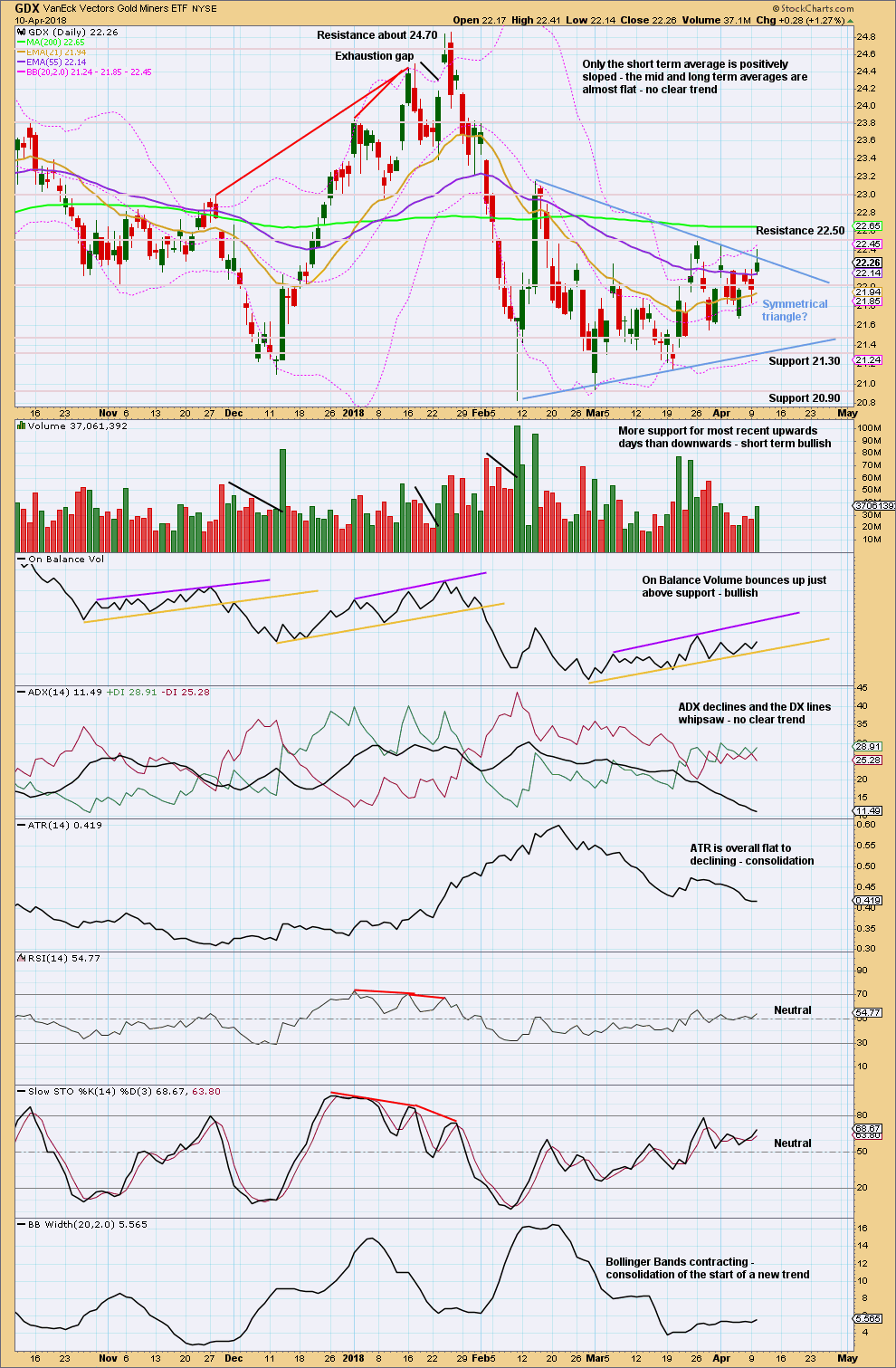
Click chart to enlarge. Chart courtesy of StockCharts.com.
GDX is range bound at both weekly and daily time frames. The smaller consolidation here has resistance now about 22.50 and support about 21.30 and 20.90.
On Balance Volume is also constrained.
A symmetrical triangle may be forming. A breakout would require a close above resistance or below support, preferably with support from volume. A target for the next trend may be calculated after a breakout. The upper wick on today’s candlestick is an overshoot, not a breakout.
The short term volume profile remains bullish.
Published @ 10:59 p.m. EST.

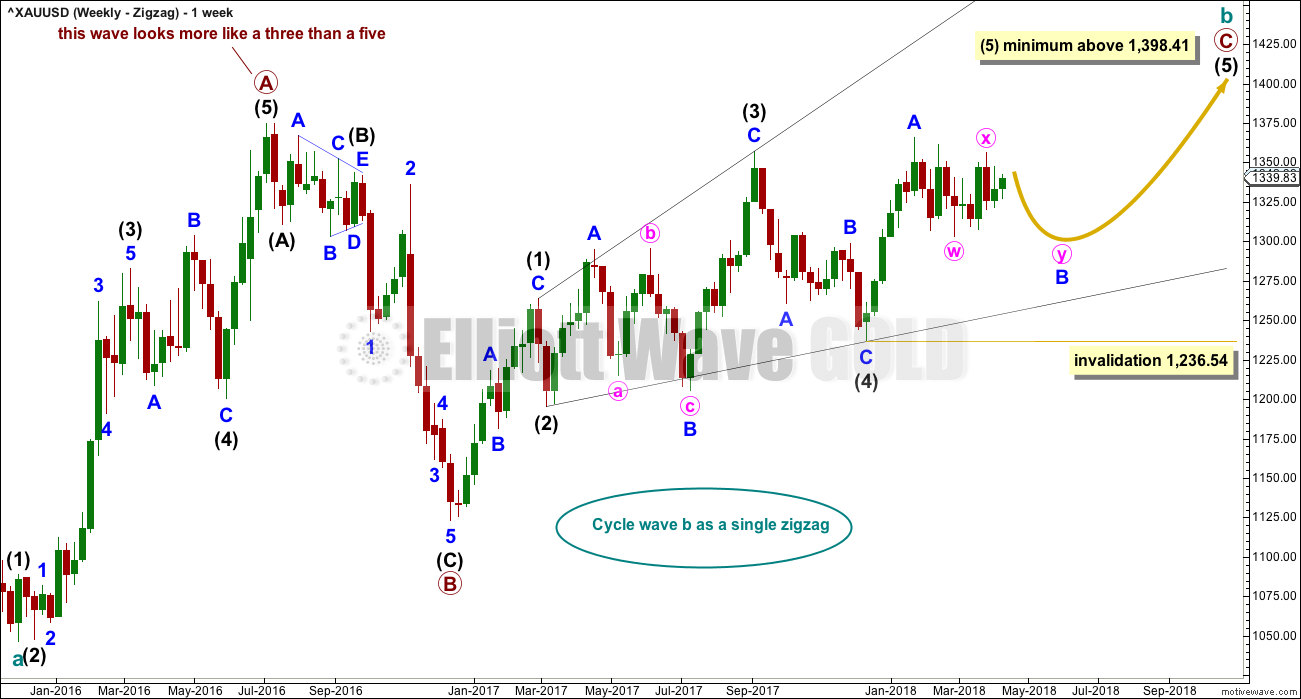
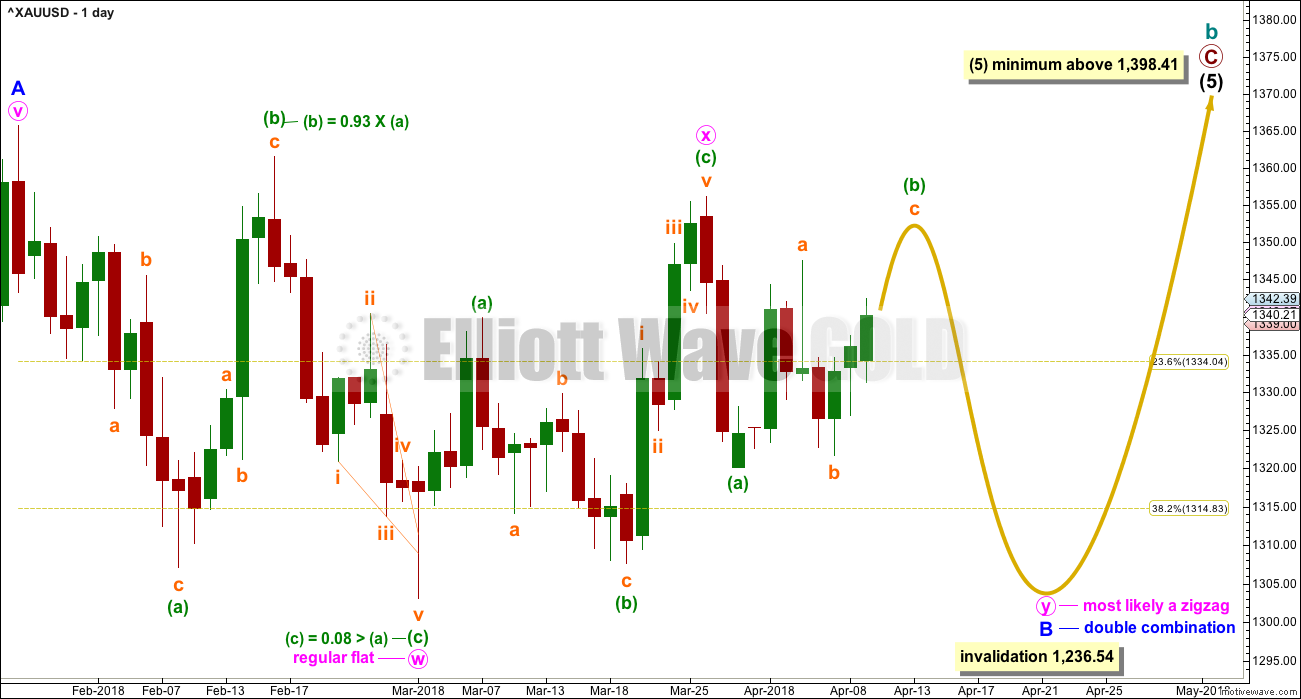
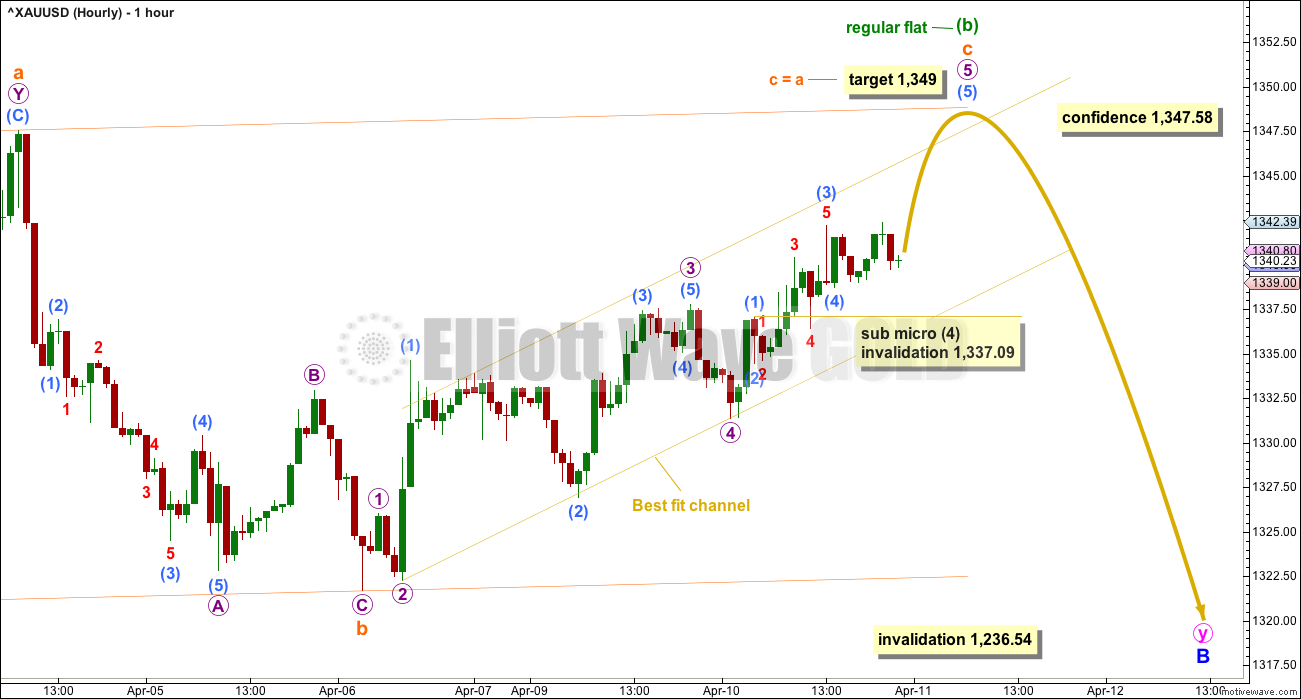
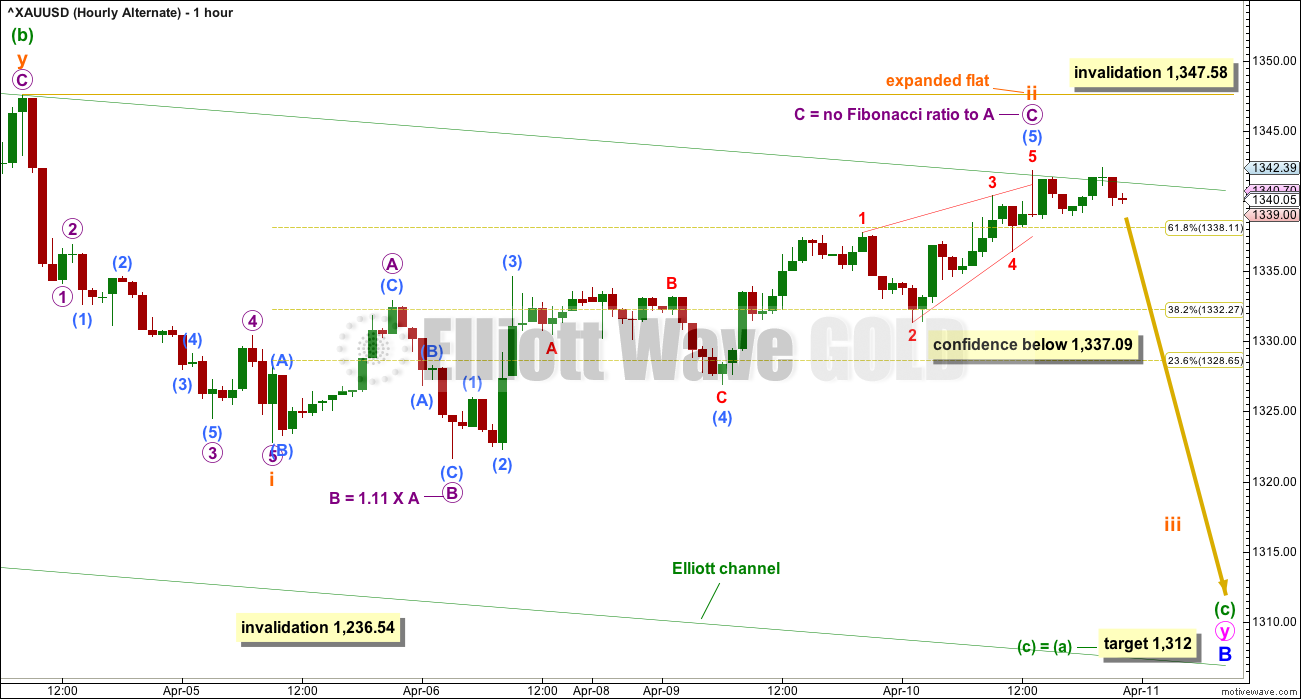
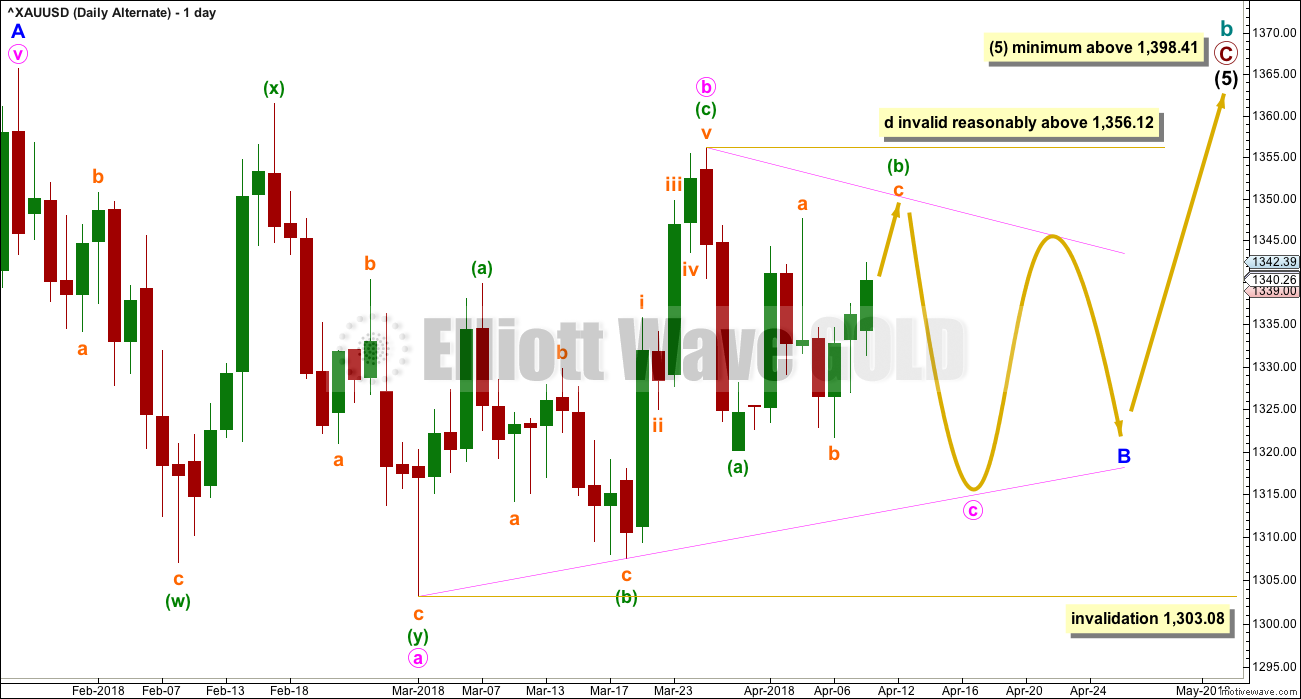
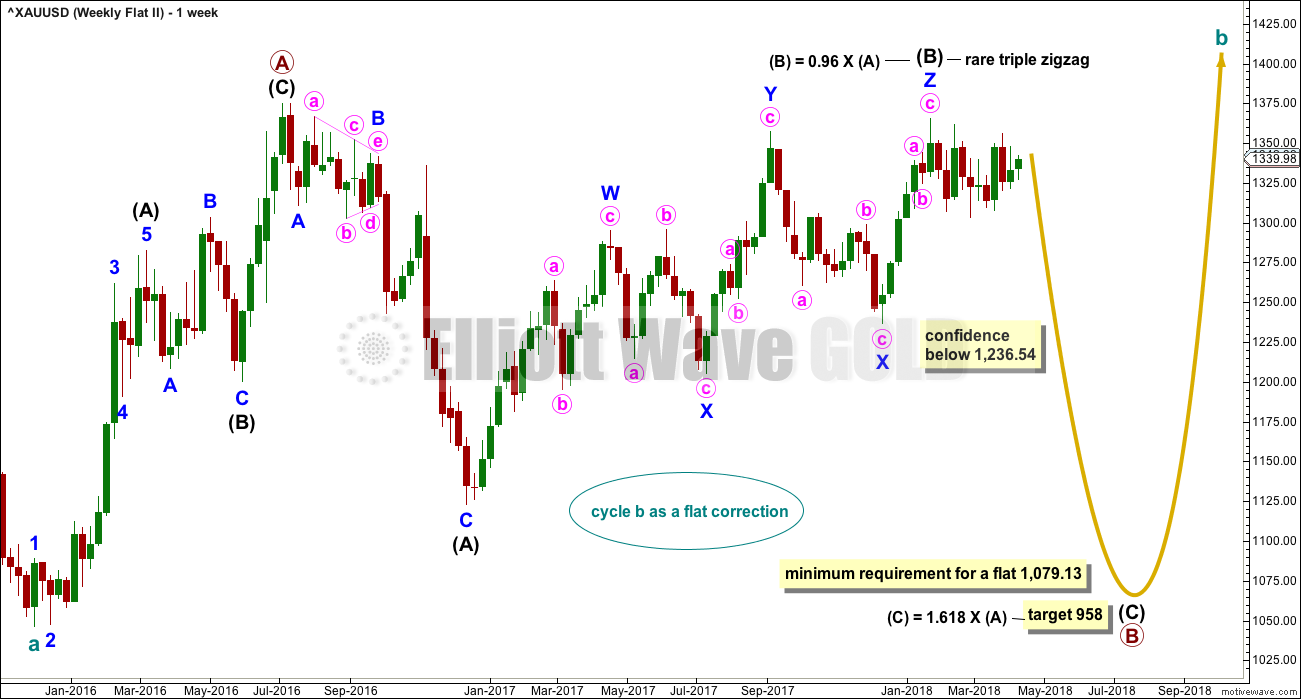
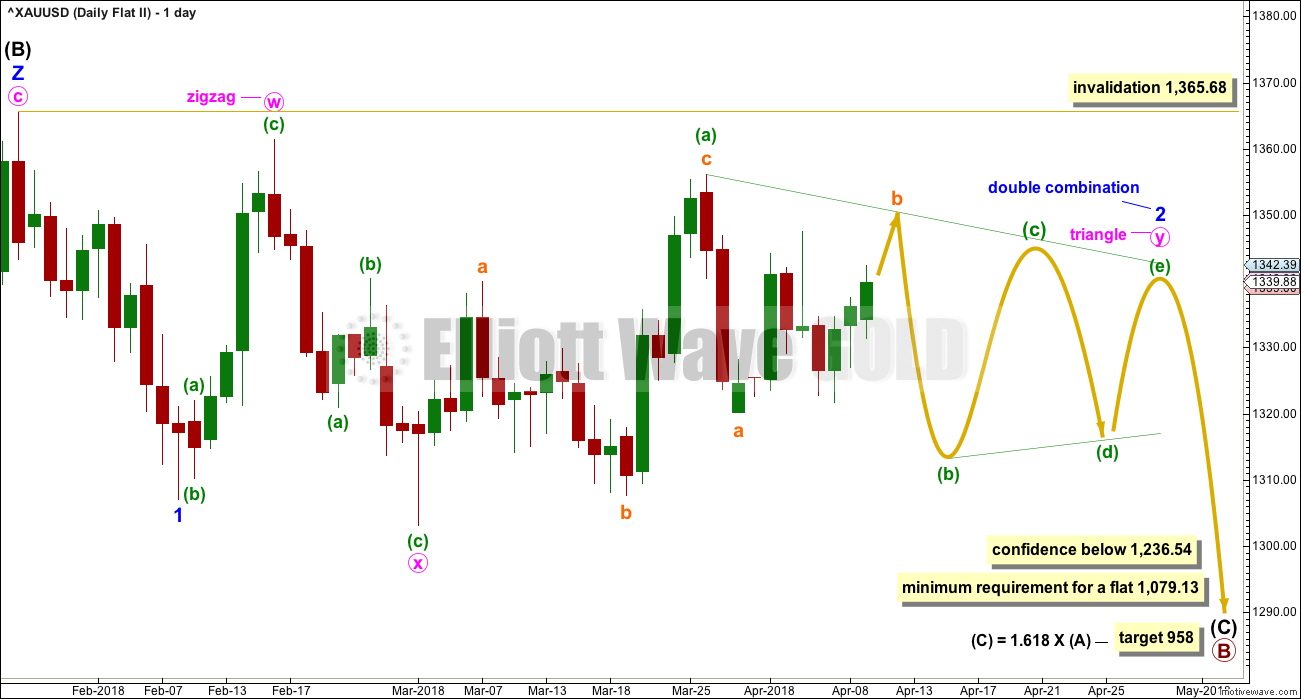
Folks, with the invalidation today on US Oil I’ve updated the daily charts for both counts and the classic TA. Posted in comments over on Oil.
Thanks for the updates Lara. Very helpful!
A double flat looks most likely now for minor B.
This second flat is an expanded flat. Nice alternation with the regular flat for minute w.
The target on the hourly chart below expects the most common Fibonacci ratio between minuette waves (a) and (c) for an expanded flat. It’s also right in that strong support zone.
Today sure does look like a blow off top with a sharp reversal. I’m reasonably confident here of a downwards swing now unfolding.
Daily updated:
Hourly updated:
Lara, any updates before the market close?
Yes. It’s coming. Apologies for the lateness
If GSR closes below 79 gold and silver will resume bullish trend.
Concerning is minor wave B target 1312.
Lara what happens if gold closes above 1365? Will bullish wave count change?
You probably have several counts which are not publish.
Lara’s wave count analysis is the best and it has been right on since 2017 into 2018.
Thanks for your excellent analytical work.
Patiently waiting for a bullish position on gold. GDX is hinting that the takeoff should be coming soon…
Lara, I’m going to post a question in your oil analysis if you get a chance to look there…
Well back to the drawing board can’t catch a break gold outside of Bollinger Bands will it retrace or just keep pushing. Really felt like we should be long but trusted in the Elliott count good luck all
It’s been very range bound but I’ve had some luck trying to catch reversal’s. These charts along with other info have worked out ok. Win some, lose some, but with that said The One Day on this chart show’s it going up a bit (which I’m guessing will be through Monday sometime) then start it’s retracement next week before shooting up. I could be very very wrong. Who knows?
Thanks for letting me know here Ari. I see Oil’s invalidated the main count. I’m working on what else could be happening, and of course there’s still the alternate.